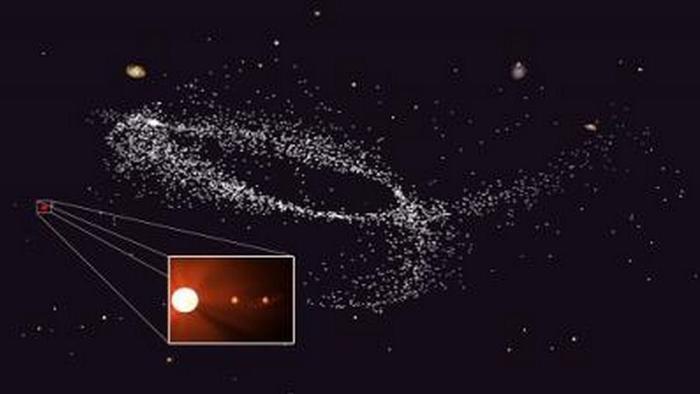Science
Related: About this forumTwo ancient worlds found just 13 light-years from Earth

Kapteyn's star and its planets are thought to come from a dwarf galaxy that has merged with the Milky Way. (Courtesy of Victor Robles, James Bullock and Miguel Rocha at UC Irvine, and Joel Primack at UC Santa Cruz)
DEBORAH NETBURN
Scientists have discovered two ancient planets orbiting a strange old star right in our stellar backyard.
One of the newly found planets is perhaps five times the mass of Earth, and astronomers believe it is the right distance from the host star to potentially sustain liquid water on its surface. That means it could be suited for life.
The second planet is even bigger -- a super-Earth, but it is probably too cold to support liquid water.
And researchers say there may be more planets in the system as well.
more
http://www.latimes.com/science/sciencenow/la-sci-sn-two-new-planets-kapteyns-star-20140603-story.html
niyad
(113,235 posts)longship
(40,416 posts)And an unusual class of M-type dwarf., called a sub-dwarf. It may not be stable enough to host life-bearing planets.
Interestingly, it has the second highest proper motion of any known star (moving faster across sky coordinates). Barnard's star is faster.
Love this stuff.
R&K
Tansy_Gold
(17,851 posts)But I still find it fascinating.
K&R anyway.
longship
(40,416 posts)They are about 75% of the stars in the galaxy/universe. They are a lot smaller and cooler than the sun. But they live for a lot longer because they burn a lot slower. It is likely that every M-dwarf ever made is still burning as bright as they ever did.
But, for some reason, some are unstable, flinging off bright flares which might be a problem for any planets orbiting around them. Also, as they are smaller and cooler, any planet would have to be pretty damned close to the star in order to be habitable. This causes issues, but as most of the stars in the galaxy are M-dwarfs, and as they live so fucking long, it is very likely that if extraterrestrial life has a chance anywhere, it could very well be on a planet orbiting an M-dwarf.
Hope that helps.
Science is awesome. Astronomy and astrophysics are the top of the heap. (IMHO)
Spitfire of ATJ
(32,723 posts)...so they said it was a waste of time to even look at them.
Now we know planets are EVERYWHERE.
BrotherIvan
(9,126 posts)longship
(40,416 posts)Only that they wouldn't have any planets in a habitable zone. It is very narrow for small, relatively cool stars. Also, the Goldilocks zone is not only narrow, it is quite close to the star, so there are gravitational and tidal issues. A planet that close to a star is likely to be tidally locked so that it has one face continuously facing the star, just like Earth's moon. That is not very good for forming habitats for advanced life; one hemisphere perpetually in daylight, one perpetually in cold night, and probably horrific winds between the light/warm hemisphere and the dark/cold one.
We will see, as M-dwarf planetary systems are relatively easy to discover and study if they are close enough to us. And there are a whole lot of them around.
Those kind of stars live an awfully long time, after all.
Spitfire of ATJ
(32,723 posts)Once again our "unique" nature would turn out to be boringly common.
Or, as was said to describe Earth, "What a miserable little mudball." ![]()
longship
(40,416 posts)Spitfire of ATJ
(32,723 posts)
....is what makes other advanced civilizations determine that we are not ready.
tclambert
(11,085 posts)If it's not too variable, I bet microbes would find a way to survive.
I expect you're right about low chances for advanced life. Well, the chances for that seem low everywhere. What did we have here, two and half billion years of only microbes before multicellular life got going?
Tansy_Gold
(17,851 posts)I regret that I went to school during an age when girls weren't encouraged as much in the sciences, such that if you had difficulty grasping a particular concept, the teachers just kind of wrote the girls off with a nice little pat on the head.
So I don't know all that much about science, but enough to appreciate it.
And enough to understand your explanation. Thank you!
longship
(40,416 posts)Best regards,
LS
Our Galaxy is now in the brief springtime of its life -- a springtime made glorious by such brilliant blue-white stars as Vega and Sirius, and, on a more humble scale, our own sun. Not until all these have flamed through their incandescent youth, in a few fleeting billions of years, will the real history of the universe begin.
It will be a history illuminated only by the reds and infrareds of dully glowing stars that would be almost invisible to our eyes, yet the somber hues of that all-but-eternal universe may be full of color and beauty to whatever strange beings have adapted to it. They will know that before them lie, not the millions of years in which we measure the eras of geology, nor the billions of years which span the past lives of the stars, but years to be counted literally in trillions.
They will have time enough, in those endless aeons, to attempt all things, and to gather all knowledge. They will not be like gods, because no gods imagined by our minds have ever possessed the powers they will command. But for all that, they may envy us, basking in the bright afterglow of Creation -- for we knew the universe when it was young.
--Arthur C. Clarke, Profiles of the Future
But the large, hot stars burn through their fuel so quickly. Stars like Sirius and Vega won't last very long. They will die long before Sol. Most of the bright, named stars in the sky are similarly doomed. The bigger and hotter they are, the shorter their life.
And long after old Sol's future white dwarf dims as its fusion furnaces cool, the M-dwarfs will still be burning, slow and steady. Life, if it exists on planets around them, could have an extraordinary chance. There would be a lot of time.
Tommymac
(7,263 posts)Alien race harnesses unstable energy pulses of star to basically use it as an engine for travelling through intergalactic space - hence the unusual trajectory - have a huge Earth like world to support a population for eons, or maybe it's a Dyson Sphere... and have engineered a larger, frozen ball of water and resources so they don't have to mine the habitable planet and ruin it's ecosphere... if it has a ring world or a diamond of smaller worlds...ye gods.
![]()
![]()
![]()
Thanks for the hard science though - reality is just as fascinating as fiction - in some cases more so.
longship
(40,416 posts)I bow to your SciFi imagination. But without real science you guys would have nothing...
Wait a minute... Or, would you?
![]()
![]()
pscot
(21,024 posts)5 earth gravities produce? Would flight be possible?
longship
(40,416 posts)One would have to know both mass and size of the planet to know the surface gravity.
Maybe there's more info from another source?
![]()
pscot
(21,024 posts)Experience a moment of Duh.
One of the newly found planets is perhaps five times the mass of Earth
longship
(40,416 posts)Not just mass. 4.5 times the mass does not mean 4.5 times the gravity. Physics 101.
Here's a better source for this discovery, Universe Today: http://www.universetoday.com/112363/discovered-two-new-planets-for-kapteyns-star/
Regards
![]()
caraher
(6,278 posts)longship just happens to know enough physics to realize that surface gravity and mass are not directly proportional - that's true only if the planets you're comparing have identical radii. For instance, Jupiter has over 300 times the mass of Earth but would have a surface gravity only about 2.5 times greater, because it also has a much bigger radius.
The only moment of Duh comes from recognizing the "g"=GM/R, which depends not on just M but R as well. And if that formula is meaningless to you then refrain from knocking longship
pscot
(21,024 posts)I was giving him the business. He's a smarter than I am, I have no doubt. He probably clicked the link; I read the OP.
it's hard to tell tone online!
There's plenty of science-based speculation about life on high-G worlds out there, much concerned with scaling laws...
eppur_se_muova
(36,257 posts)Thicker atmosphere means more friction, but also more lift for airfoils and flapping wings. A thicker atmosphere could likely support much larger birds, and flight might be much more common among organisms on such a planet.
SF writers who want their stories to involve intelligent flying creatures usually place their stories on planets with thick atmospheres.
The denser the atmosphere, the easier it is to achieve lighter-than-air flight. There has been serious speculation that gas giant planets might harbor living hydrogen-filled gasbags.
liberal N proud
(60,334 posts)